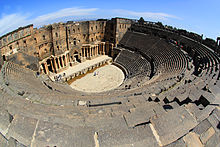
Back ثقافة سوريا Arabic Cultura de Síria Catalan Cultura de Siria Spanish فرهنگ در سوریه Persian Culture de la Syrie French सीरिया की संस्कृति Hindi Սիրիայի մշակույթ Armenian Kebudayaan Suriah ID სირიის კულტურა Georgian സിറിയയുടെ സംസ്കാരം Malayalam
This article needs additional citations for verification. (December 2024) |
| Part of a series on the |
| Culture of Syria |
|---|
 |
| History |
| People |
| Languages |
| Cuisine |
| Religion |
| Art |
| Literature |
| Music |
| Sport |


Syria is a traditional society with a long cultural history.[1] The Syrian's taste for the traditional arts is expressed in dances such as the al-Samah, the Dabkeh in all their variations and the sword dance. Marriage ceremonies are occasions for the lively demonstration of folk customs.[2]
The scribes of the city of Ugarit (modern Ras Shamra) created a cuneiform alphabet in the 14th century BC. The alphabet was written in the familiar order we use today like the English language, however with different characters.[3]
Archaeologists have discovered extensive writings and evidence of a culture rivaling those of Iraq, and Egypt in and around the ancient city of Ebla (modern Tell Mardikh).[4] Later Syrian scholars and artists contributed to Hellenistic and Roman thought and culture. Cicero was a pupil of Antiochus of Ascalon[5] at Athens; and the writings of Posidonius of Apamea[6] influenced Livy and Plutarch.
- ^ Hopwood, Derek (1988). Syria 1945–1986: Politics and Society. Routledge. ISBN 0-04-445039-7.
- ^ Salamandra, Christa (2004). A New Old Damascus: Authenticity and Distinction in Urban Syria. Indiana University Press. p. 103. ISBN 0-253-21722-9.
- ^ Gordon, Cyrus Herzl (1965). The Ancient Near East. W.W. Norton & Company Press. ISBN 0-393-00275-6.
- ^ An up-to-date account for the layman, written by the head of the archaeological team that uncovered Ebla is Paolo Matthiae, The Royal Archives of Ebla (Skira) 2007.
- ^ Plutarch, Cicero, c. 4; Lucullus, c. 4; Cicero, Academica, ii. 19.
- ^ Chisholm, Hugh, ed. (1911). . Encyclopædia Britannica. Vol. 22 (11th ed.). Cambridge University Press. p. 172.